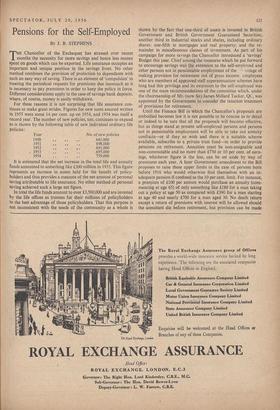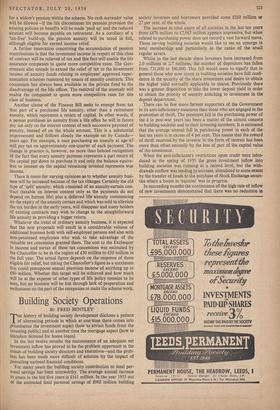Pensions for the Self-Employed
BY J. B. STEPHENS THE Chancellor of the Exchequer has stressed over recent months the necessity for more savings and hence less money spent on goods which can be exported. Life assurance occupies an important and unique position in the savings front. No other method combines the provision of protection to dependants with such an easy way of saving. There is an element of 'compulsion' in meeting the periodical requests for premiums due inasmuch as it is necessary to pay premiums in order to keep the policy in force. Different considerations apply in the case of savings bank deposits, where, of course, money is easily withdrawn.
For these reasons it is not surprising that life assurance con- tinues to make great strides. Figures for new sums assured written in 1955 were some 14 per cent, up on 1954, and 1954 was itself a record year. The number of new policies, too, continues to expand as is shown by the following table of new .individual ordinary life policies : Year
No. of new policies 1950
. • • • 641,000 1951 • .
• • 698,000 1952 • • • •
r. •
691,000
. 1953
695,000 1954
759,000 It is estimated that the net increase in the total life and annuity funds amounted to something like £300 million in 1955. This figure represents an increase in assets held for the benefit of policy- holders and thus provides a measure of the net amount of personal saving attributable to life assurance. No other method of personal saving achieved such a large net figure.
In total the life funds amount to over £3,500,000 and are invested by the life offices as trustees for their millions of policyholders to the best advantage of those policyholders. That this purpose is not inconsistent with the needs of the community as a whole is
shown by the fact that one-third of assets is invested in British Government and British Government Guaranteed Securities; another third in industrial stocks and shares, including ordinary shares; one-fifth in mortgages and real property; and the re- mainder in miscellaneous classes of investment. As part of his campaign for more savings the Chancellor introduced a 'savings' Budget this year. Chief among the measures which he put forward to encourage savings was the extension to the self-employed and other persons not in pensionable employment of the ntage of making provision for retirement out of 'gross income. thriployees who are members of approved'staff superannuation schemes have long had this privilege and its extension to the self-employed was one of the main recommendations of the committee which, under the chairmanship of Mr. (now Sir) James Millard Tucker, QC, was appointed by the Government to consider the taxation treatment of provisions for retirement.
Until the Finance Bill in which the Chancellor's proposals are embodied becomes law it is not possible to be concise as to detail or indeed to be sure that all the proposals will become effective, but as things stand at present self-employed persons and persons not in pensionable employment will be able to take out annuity contracts—or if they so wish and there is a suitable scheme available, subscribe to a private trust fund—in order to provide pensions on retirement. Annuities must be non-assignable and non-commutable and no more than £750 or 10 per cent, of earn- ings, whichever figure is the less, can be set aside by way of premiums each year. A later Government amendment to the Bill proposes to raise these upper limits in the case of persons born before 1916 who would otherwise find themselves with an in- adequate pension if confined to the 10 per cent. limit. For instance; a premium of £100 per annum would purchase an annuity (com- mencing at age 65) of only something like £180 for a man taking out a policy at age 50 as compared with £390 for a man starting at age 40 and nearly £700 for a man aged 30. No death return. except a return of premiums with interest will be allowed should the annuitant die before retirement, but provision can be made
for a widow's pension within the scheme. No cash surrender value will be allowed—if the life discontinues his pension provision the existing policies or benefits will be made 'paid up' and the reduced amount will become payable on retirement. As a corollary of a 'tax-free' build-up, the pension annuity will be taxed in full, although eligible for earned income relief.
A further innovation concerning the accumulation of pension contributions is that the investment income in respect of this class of contract will be relieved of tax and this fact will enable the life assurance companies to quote more competitive rates. The Gov- ernment also intends to extend the relief of tax to the investment income of annuity funds relating to employees' approved super- annuation schemes reassured by means of annuity contracts. This concession has always been available to the private fund to the disadvantage of the life offices. The removal of the anomaly will enable the companies to quote more competitive rates for this class of business.
Another clause of the Finance Bill seeks to exempt from tax that part of a purchased life annuity, other than a retirement annuity, which represents a return of capital. In other words, if a person purchases an annuity from a life office he will in future pay tax only on the interest content of each successive payment of annuity, instead of on the whole amount. This is a substantial improvement and follows closely the example set by Canada— years ago. For example, a man purchasing an annuity at age 65 Will pay tax on approximately one-quarter of each payment. The change in practice is, however, no more than belated recognition of the fact that every annuity payment represents a part return of the capital put down to purchase it and only the balance equiva- lent to interest on the capital remaining invested represents true income.
There is room for varying opinions as to whether annuity busi- ness will be increased because of the tax changes. Certainly the old type of 'split' annuity, which consisted of an annuity-certain con- tract (taxable on interest content only as the payments do not depend on human life) plus a deferred life annuity commencing on the expiry of the annuity certain and which was sold to alleviate the tax burden in the early years, will disappear and many holders of existing contracts may wish to change to the straightforward life annuity as providing a bigger return.
Whatever the trend of ordinary annuity business, it is expected that the new proposals will result in a considerable volume of additional business both with self-employed persons and also with non-pensioned employees who wish to take advantage of the valuable tax concession granted them. The cost to the Exchequer in income and surtax of these tax concessions was estimated by the Chancellor to be in the region of £30 millitrn to £50 million in the full year. The actual figure depends on the response of those eligible for relief, but taking the Chancellor's figure as a maximum this could presuppose annual premium income of anything up to £80 million. Whether this target will be achieved and how much Will be at the expense of other types of life policy remains to be seen, but no business will be lost through lack of preparation and enthusiasm on the part of the companies to make the scheme work.



















































 Previous page
Previous page